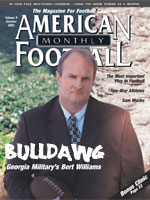The Punt: The Most Important Play in Football?
by: Sidney A. McNairy IIIMorgan State University©
More from this issue
I would like to first say thank you to American Football Monthly
for allowing me the opportunity to write this article for my peers.
Additionally, I thank our head coach Don Hill for giving me the
chance to control such a big part of the team’s success.
It has been a great experience to be part of such a big turnaround.
Under his guidance, we were able to take a team with a 23-year
losing streak and go on to finish the season with seven wins and
five losses.
As the special teams coordinator, it has been great to work with a group of people
that share in one vision. We all played a big part in a phase of the game that
we believed could take over and control the outcome of the game. We also had
the delight to have players with great character. Their character and belief
in the system allowed us to implement the schemes we used to dominate every part
of special teams.
We used our special teams unit to allow players, which would not normally play
in the course of a game, to contribute and take ownership in the team. It was
our belief that our special teams would set the tone of every game. We wanted
to start strong and dominate every time we took the field. It was important that
everyone believed in our motto: “We will reach to achieve the perfect game
each and every time we take the field we will strive for perfection.” Players
had to play within the scheme of the call, execute their assignment and give
great effort through the echo of the whistle. Remember, as you begin to implement
your plan, there are several ways to have success in any phase of special teams.
Make sure that you can transfer the belief of the system to the players and that
it can be taught to perfection.
As you start to plan how you will attack the area of special teams, it will be
important to remember that the most important play of the game will be with your
punt team. In order to have a successful punt team, you must make sure to keep
these points in mind:
•
Know the formation you will use.
•
Know the responsibilities of each player.
•
Know how each player will fit into the scheme.
•
Know how you will execute the punt.
•
Know how to protect the punter.
•
Know how to cover the punt and stop the returner.
•
Execute the play.
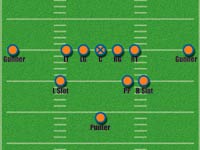 Diagram 1. The Formation
Diagram 1. The Formation |
When implementing your plan, start with the basics. It is important
for your players to understand what you are trying to accomplish.
Spend time in the classroom
making sure that everyone knows the rules, where to go and how to get there.
After understanding the rules, the next priority is to make sure that the formation
is installed and proper spacing is used. We used a spread punt formation (diagram
1). This formation gave us the ability to protect our punter, the ability to
cover and stop the return-man, while allowing us the option to run fakes and
create positive results in our team’s favor. The center aligns quickly
and directly over the football. Working from the center out, the guards will
align next to the center split out 6 inches. The tackles will then get set
next to the guard with a one-foot split. The gunners will have a split approximately
12 yards outside of the tackles. The next step is to get the slots and personal
protector set. The slot will align 5 yards deep just outside of the tackles.
The personal protector will also align 5 yards deep to the left or right of
the
center. The side of the personal protector will be determined based on the
protection responsibility. The punter will be positioned directly behind the
center 15 yards
deep.
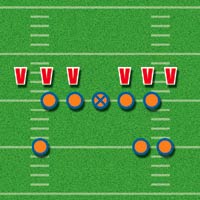 Diagram 2. Basic Rush Look
Diagram 2. Basic Rush Look
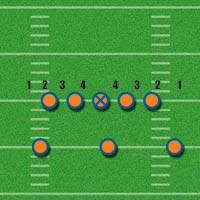
Diagram 3. Danger Rush Look
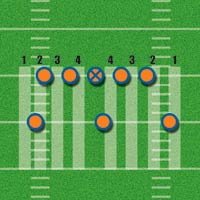
Diagram 4. Protection Zones
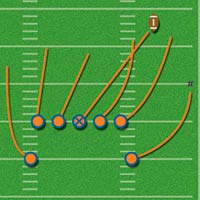
Diagram 5. Coverage Lanes with Right Punt
|
When installing the protection, a general understanding of the punt is a must.
By being a directional punting team, it must first be determined if the punter
will be kicking to the right or to the left. This will identify if the right
or left will be the most important side of the protection and will let everyone
know the direction the ball should travel. Once the direction is established,
determine how the rush team will be blocked. The first thing is to see how many
rushers are immediate threats. An identification system will be used based on
the count. A three-man rush to a side will be a basic look (diagram 2); a four-man
look to a side will be a danger look (diagram 3). By using a man within a zone
scheme, you will be able to protect against any look. The system has four zones
to each side of the center. It is important to establish a counting system that
will allow the players to identify who will block each rusher within each zone.
The outside zone will belong to the slots; the second zone will belong to the
tackles; the third zone will belong to the guards. The inside fourth zones will
be taken by the long snapper and personal protector (diagram 4).
Once the protection has been thoroughly explained, it is time to enter the second
part of the play, the coverage. It is critical that each of the players understand
their role in coverage to minimize the return yards by the opposition. When the
ball has been successfully punted; the gunners, long snapper, and personal protector
will attack directly to the return man. The landmarks will be established from
the middle of the field as the ball travels to one side or the other. Landmarks
will widen to the side of the ball placement in the cases where the ball has
moved toward the left or right hash. The landmarks are as follows for the slots,
tackles and guards (See chart below): (See also: diagram 5)
Taking the field
Phase 1 (The basics)
After reviewing the scheme in the classroom, it is time to take the field.
Start with a teaching phase that will allow you to prepare for execution
of the play.
The first priority is to make sure that each player understands what technique
they will use. The guards and tackles will go together, slots and personal
protector, gunners, and the long snappers and punters will go together to
work on (phase
one) the basics. Phase one will consist of the stance and technique at each
position. The long snapper will be in a four-point stance that will allow
him to have both
hands on the football and to be able to snap the football with speed and
precision. Guards and tackles will use a sprinter’s two-point stance with both hands
positioned on the inside knee. It is important to have good knee bend, shoulders
forward and chest over the front knee to create a stance that will eliminate
false movement, allow the player to stay square and low for blocking. The next
positions will be the slots and personal protectors. These positions will use
a two-point linebacker’s stance. Again making sure to eliminate false movements
while allowing the players to stay square and low for blocking. The gunners will
use one of two stances based on their comfort for releasing down the field. The
first stance will be a receiver’s stance, or they may align in a two-point
stance with the shoulders square to the line of scrimmage. Remember that
the guards, tackles and gunners must align on the line of scrimmage. The
punter
will use a two-point stance that will allow him to field the ball, and then
execute
the punt.
Phase 2 (Technique Drills)
The second part of the on-the-field implementation will be Phase II, technique
drills. By breaking down into smaller groups, it will be easier for each position
to get work that will allow each person to perfect each individual technique.
The guards, tackles, and slots will work together to execute the initial block
sequence.
The Drop Drill
The guards and tackles will perform the drop drill; this will ensure the drop
used to establish a pocket for the punter. The drill is worked across the field
and a ball can be used to establish a line of scrimmage. By having the players
start in their stance and on the snap, have the players take their drop and reset.
Using the yard lines will ensure a straight drop.
The Patience Drill
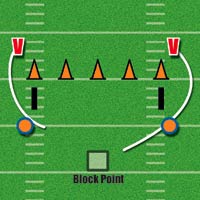 Diagram 6. Patience Drill
Diagram 6. Patience Drill |
While the drop drill takes place, the slots will work on a patience
drill. This drill is done in order to teach the technique of the
slot in protecting
the edge
and the line to the block point. Using the ball to establish a line of
scrimmage, the slot will get the width of his normal alignment.
The rusher will align
outside of the slot. A player may stand where the tackle would end up in
his drop or
a bag may be set. A bag may be set at nine yards where the punter’s
foot will end up when the ball is kicked. The rusher will now try to get
to the
block point when the whistle is blown. As the slot, it is important to
understand not
to chase the rusher outside and to keep the rusher from getting to the
block point (diagram 6).
The 3-on-3 Drill
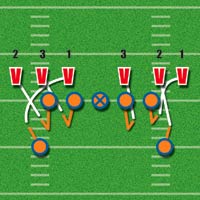 Diagram 7. 3-on-3 Drill
Diagram 7. 3-on-3 Drill |
After the drop and patience drills have been performed to your expectations,
it is then time for the slots, guards, and tackles to come together for the 3-on-3
drill. The drill will be performed in the punt formation eliminating the long
snapper, personal protector and punter. The right and left side may work at separate
speeds. A coach can use a cadence or whistle to have the rushers and punt team
begin the drill. The rushers will be instructed to use a straight rush or a twist
rush (diagram 7). The protection unit will take their punt drop and execute the
protection. The players will learn to handle different looks and create confidence
in each other.
The Release Drill
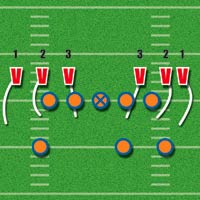 Diagram 8. Six Man Straight Rush
Diagram 8. Six Man Straight Rush
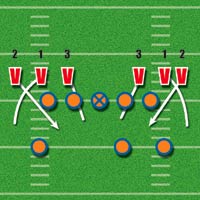
Diagram 9. Eight Man Straight Rush
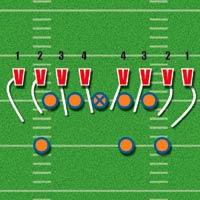
Diagram 10. Six Man Twist Rush
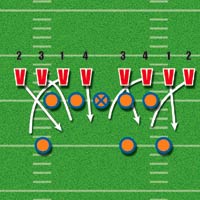
Diagram 11. Eight Man Twist Rush
|
Another field drill, the release drill, will be done to perfect the technique
for the gunners. This drill will be performed to aid the gunners in getting off
the line of scrimmage and covering the punt. The gunner will align on the football
or line of scrimmage. A defender will be designated to jam the gunner and prevent
coverage. Again the coach can use a cadence or whistle to tell the gunner when
to work for a release down the field. After several repetitions have been performed,
the drill should be adapted for two defenders as well. During the initial drill
period, the long snapper, personal protector, and punter will work together to
establish calls and to work on timing.
Phase 3 (The Full Picture)
Once the individual techniques have been established, the next phase is to work
against a full picture. In phase three the punt team will perfect the protection
against a six and eight man straight rush, a six and eight man with a twist,
as well as an overload right and left. During this phase, the gunners will now
work from one side of the protection and continue to work on their release technique
while covering to the returner. (See diagrams 8-11)
Phase 4 (Drilling the Coverage)
Once the players become comfortable with their techniques it will be time to
move on to phase four, drilling the coverage. Phase four should be executed without
a rush first so that the coaches can make sure that each player is covering to
their lane responsibility. This will insure that everyone gets a feel for how
they fit into the coverage net. Once lanes have been established on air, the
punt team will now face a rush. At this time the protection will be executed
and the interior unit should fan their lanes and cover for ten yards after the
ball is kicked. During this step, cones can be set up for the interior to work
for their landmarks. This will place a focus on the players becoming aware of
their precise landmarks.
Phase 5 (The Quiz)
After phase four has been executed it is now time to move on to the quiz. This
will consist of scrimmaging against a live return team. During the scrimmage,
it is important to make sure that the protection is made, that lanes are fanned
and that the ball carrier is stopped from making progress.
Phase 6 (The Game)
The final phase is the test that we must be able to withstand each and every
week. When the players take the field on game day, they will need to have the
confidence in the scheme, the knowledge to make adjustments on the field, and
the precision that will allow them to win the most important play of the game.
Many teams have overlooked the importance of the punt, which has to be executed
with great success in order to gain valuable field position and to keep from
giving up a sudden change in the outcome of the game. Remember as you prepare
for the most important play in football, pay close attention to the many details
that will come with the situations that may arise through the course of the game.
About
the author
Sidney McNairy, III
Sidney McNairy is in his third season as the Bears’ special
teams coordinator and receivers coach. Prior to coming
to Morgan State, McNairy spent six years as a wide receiver
coach at Northern Illinois University. He also coached
at Eastern Illinois and his alma mater Purdue where he
got his start. McNairy is a native of Gaitherburg, Md.
He graduated from Purdue in 1993 and earned his master’s
degree in physical education from Eastern Illinois in
1995.
At Purdue, McNairy sustained an injury prior to football season that ended his
football playing career. His setback failed to end his athletics career as he
went on to play two years on the Boilermaker soccer team.
For more info, email
sidneymcnairy@morgan.edu
|
|
